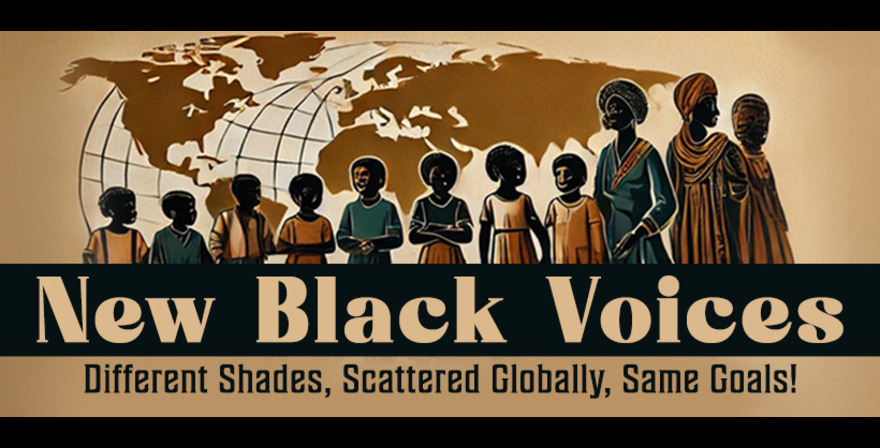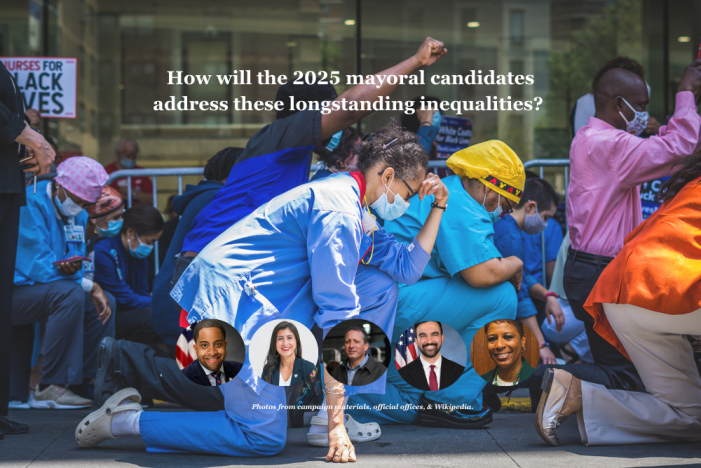By Brian Figeroux, Esq.
New York City’s economy in 2025 is a city of contradictions. Wall Street profits have soared, tech startups are thriving in hubs like Brooklyn’s Industry City, and tourism has roared back after pandemic-era slumps. Yet for hundreds of thousands of non-white New Yorkers, the reality of daily work remains precarious: unstable wages, limited benefits, and systemic barriers to opportunity.
Non-white workers — particularly Black, Latino, and Asian populations — make up the backbone of the city’s service, health care, and construction industries. Yet they are disproportionately concentrated in lower-wage, higher-risk sectors, often without sufficient access to health insurance, job protections, or clear paths for advancement. As the 2025 mayoral election approaches, the concerns of these workers cannot be ignored. The future of the city depends on whether the next mayor is willing to confront entrenched inequalities head-on.
This analysis dives deep into the New York City job market as it stands today, examines where non-white workers are employed, evaluates whether they enjoy fair pay and benefits, and outlines the most pressing issues that mayoral candidates must address to create a truly inclusive and equitable economy.
NYC Job Market Overview
The New York City job market in 2025 is shaped by powerful forces: technological change, an evolving service economy, and the lingering impacts of the 2023 national recession. While unemployment is lower than it was two years ago, recovery has been uneven across industries and racial groups.
Healthcare remains one of the city’s largest employers, driven by an aging population and expanded medical infrastructure. Hospitality and tourism have rebounded strongly, with hotels, restaurants, and entertainment venues hiring aggressively — but often at low wages. Retail, meanwhile, continues to undergo seismic shifts due to e-commerce growth, leading to fewer stable brick-and-mortar jobs.
Construction has boomed, particularly in outer boroughs like the Bronx and Queens, where residential and commercial development are reshaping neighborhoods. Tech jobs have also grown, but their benefits have been disproportionately captured by white and Asian workers with advanced degrees.
Gig work — through platforms like Uber, DoorDash, and TaskRabbit — remains a significant but unstable source of income for many, often without benefits or wage protections. Remote work has become permanent in many white-collar sectors, but these jobs are less accessible to workers without college degrees.
Overall, while the city boasts a resilient economy on paper, the quality of jobs available to most working-class New Yorkers remains a major concern.
Where Non-White Workers Are Employed
In 2025, the racial breakdown of employment across New York City’s industries reveals entrenched patterns:
- Healthcare: Approximately 45% of healthcare support workers (nursing aides, home health aides) are Black or Latino.
- Hospitality and Food Services: Around 65% of workers are non-white, with a significant number of Latino and immigrant Asian workers.
- Retail: Roughly 60% of frontline retail workers (cashiers, stockers) are non-white.
- Construction: About 70% of construction laborers are Latino or Black.
- Finance and Technology: Only about 25% of employees are Black or Latino, despite making up over 50% of the city’s population.
These figures highlight a stark divide: while non-white workers are overrepresented in physically demanding, lower-wage sectors, they remain underrepresented in high-paying industries like finance, tech, and law.
Moreover, within sectors themselves, non-white workers are often clustered in lower-tier roles. For example, while the tech sector has made strides in hiring diversity, many Black and Latino employees are found in administrative support positions rather than in engineering or executive leadership.
The reality is clear: while New York prides itself on its diversity, that diversity has yet to translate into equal economic opportunity across industries.
Do They Have Well-Paying Jobs?
When it comes to wages, the data paints a challenging picture for non-white workers in New York City.
Wage disparities by race have persisted, and in some sectors, widened. According to recent figures from the NYC Comptroller’s Office (2024 report):
- The median wage for white workers in the city is about $42 per hour.
- For Black workers, the median wage falls to $29 per hour.
- For Latino workers, it drops even further to $27 per hour.
- Asian American workers show mixed outcomes: some subgroups earn wages close to whites, while others, especially immigrants from Southeast Asia, earn closer to Latino median incomes.
These gaps are especially wide in industries like construction, retail, hospitality, and health care — all sectors where non-white workers are disproportionately employed.
Additionally, the explosion of gig work and temp agency jobs has made it harder for many workers to secure steady income. Companies often classify workers as independent contractors, stripping them of minimum wage protections, overtime pay, and unemployment insurance. This is particularly common among delivery drivers, warehouse workers, and cleaners — jobs dominated by immigrants and communities of color.
Even within industries like healthcare, non-white workers are often pushed into lower-paying, higher-risk jobs like home health aide work, while better-paying positions like registered nursing and management remain disproportionately white.
In short, while jobs are plentiful in New York City, good-paying jobs with stability and growth potential are still out of reach for many non-white workers.
Access to Health Benefits
Access to healthcare is another fault line in the job market — and it’s hitting non-white workers the hardest.
Employer-provided health insurance is still the primary way Americans get coverage. But among NYC workers:
- 70% of white full-time workers have employer-sponsored insurance.
- Only 55% of Black and Latino workers have the same.
- Among gig workers (many of whom are immigrants and non-white), fewer than 25% report having any kind of job-related health benefits.
Unionized jobs — like those in public hospitals, transportation (MTA), and large hotel chains — remain a vital pathway to better benefits. But union membership has declined overall, and union jobs are highly competitive.
Many non-white workers are stuck in sectors where health benefits are rare. For example:
- Home health aides (mostly Black and Latina women) often work for agencies that offer minimal or no benefits.
- Restaurant workers (heavily Latino and Asian) frequently rely on Medicaid or remain uninsured.
The rise of “just-in-time” scheduling and freelance work has further eroded traditional employment protections, leaving many working-class families one illness away from financial disaster.
Efforts like the NYC Care program — a health access initiative for low-income and undocumented residents — have helped. However, many advocates argue that access is uneven and that navigating these systems can be overwhelming for workers facing language and literacy barriers.
Key Concerns for Non-White Workers
Heading into the 2025 election, non-white working-class New Yorkers are facing a constellation of urgent challenges:
- Job Security
Many industries that employ large numbers of non-white workers (retail, food service, gig economy) offer little job stability. Workers want guarantees against arbitrary firings, protections against exploitation, and pathways to permanent employment.
- Wages and Cost of Living
The minimum wage in NYC is currently $18 per hour (as of January 2025), but it’s not enough. According to the MIT Living Wage Calculator, a single adult with no children needs at least $23 an hour to meet basic needs in the city. Workers are demanding not just minimum wage hikes, but also automatic cost-of-living adjustments tied to inflation.
- Affordable Health Care
With many non-white workers locked out of employer-based insurance, there is a call for expanded public health programs, subsidies, and support for undocumented workers.
- Workplace Discrimination
Racial bias in hiring, promotion, and workplace discipline remains widespread. Workers seek stronger protections against discrimination and harassment, plus better representation in leadership positions.
- Affordable Housing
Housing insecurity deeply affects working-class communities. Many non-white workers spend more than 50% of their income on rent. Solutions like rent control, expanded public housing, and housing vouchers are top demands.
- Career Advancement Opportunities
Without affordable training and education programs, many non-white workers feel stuck in dead-end jobs. Expanded access to trade schools, apprenticeships, and higher education is a major priority.
What Mayoral Candidates Must Address
As New York City approaches the 2025 mayoral election, candidates face mounting pressure to address the systemic challenges confronting non-white and working-class communities. Key areas of focus include:
- Raising the Minimum Wage and Ensuring Wage Equity
While the city’s minimum wage stands at $18 per hour, many argue this is insufficient given the high cost of living. Candidates like Zohran Mamdani advocate for a living wage that reflects the city’s economic realities. Addressing wage disparities, particularly those affecting Black and Latino workers, is crucial.
- Expanding Access to Health Benefits
A significant portion of non-white workers lack employer-provided health insurance. Proposals to expand public health programs and ensure coverage for gig and part-time workers are essential. Brad Lander emphasizes the need for universal healthcare access as a cornerstone of his campaign.
- Enhancing Job Security and Workers’ Rights
The prevalence of gig economy jobs has led to increased job insecurity. Candidates are called to support legislation that offers protections for gig workers, including benefits and the right to unionize. Scott Stringer has highlighted the importance of safeguarding workers’ rights in the evolving job market.
- Investing in Affordable Housing
With many non-white workers spending over half their income on rent, affordable housing remains a pressing issue. Jessica Ramos proposes expanding rent control measures and increasing the availability of affordable housing units.
- Promoting Career Advancement Opportunities
Access to education and vocational training is vital for upward mobility. Zellnor Myrie advocates for increased funding for community colleges and apprenticeship programs to bridge the opportunity gap.
Conclusion
The 2025 mayoral election presents a pivotal opportunity to address the longstanding inequities faced by non-white and working-class New Yorkers. Candidates must prioritize policies that promote economic justice, healthcare access, job security, affordable housing, and educational opportunities. By centering the experiences and needs of these communities, New York City can move toward a more equitable and inclusive future.

